Stress and Anxiety at Work: Improving Total Wellbeing & Resilience in a World of Change

Stress and anxiety at work have been on the rise over the last decade. Opens in a new tab
Even before the pandemic, 40% of American workers surveyed by the Anxiety & Depression Association of AmericaOpens in a new tab felt persistent stress or excessive anxiety linked to work. In its aftermath, employees are 12% more likely to experience stress and 17% more likely to burnout now than they were pre-pandemic, according to MetLife's 2024 U.S. Employee Benefits Trends StudyOpens in a new tab.
Early in 2024, our Human Workplace Index survey found that 74% of the 1,000 full-time employees surveyed reported consistent (52%) or increased (32%) stress levels compared to the previous month. Our findings reflect broader trends from numerous 2023 surveys: despite positive improvements in workplace mental health awareness and benefits, employees continue to experience chronic stress and anxiety.
Common causes of workplace stress and anxiety in 2024
As the world grapples with injustice, inequity, global conflict, and climate change, an already stressed population struggles to think about the future. With a recession looming and inflation putting strain on budgets, financial stress has become Americans' most common daily stressor.
Combined with the rapid development of generative AI, workers feel increased job insecurity and productivity anxiety.
The widening gap in employee experiences and intense focus on reducing costs in the face of uncertainty has also contributed to declining psychological safety and belonging in the workplace.
Trends in the American Psychological Association's (APA) 2023 Stress in AmericaOpens in a new tab and 2023 Work in America ReportsOpens in a new tabalso indicate that while awareness of inequity and injustice has increased since the pandemic, employees have not experienced meaningful change.
Who’s feeling the pressure?
Despite common macro stressors, insecurity and work environments impact employee wellbeing in different ways and for various reasons:
Frontline workers and manual laborers
From irregular schedules and limited job autonomy to regular stressful customer interactions, frontline workers' environment puts additional strain on their wellbeing and puts them at higher risk of burnout.
Digital workforce resilience platform meQuilibrium found frontline workers were more likely to suffer from depression (61%) and anxiety (33%) than a control group of non-frontline workers (25% and 22%, respectively).
“Yet, when faced with high stress, front-line workers are 30% less likely to seek out professional assistance,” said Dr. Brad Smith, meQuilibrium’s chief science officer.
It's not only a reticence to discuss their experiences but also difficulty accessing professional support. They may be unaware of their options or having difficulty scheduling appointments around irregular work hours and schedules. The common response to stress is to take time off, which can be difficult for laborers without paid time off.
Tip: OSHA has put together tips and guidanceOpens in a new tab for frontline workers, managers, and employers to help improve these work environments, identify suffering employees, and support them.
Caregivers, parents, and women
While many find the role of caretakers fills them with a sense of purpose, the added stress can make it difficult to look after their wellbeing. Without constant support and flexibility, they may be unable to focus and likely to burn out on social, familial, and workplace responsibilities.
It's a long-term commitment that necessitates regular time and energy management and balancing financial resources against monetary and wellbeing costs. Workhuman researchers discovered that "caretakers are more likely than non-caretakers (43% vs. 34%) to be looking for a new job and fearing the loss of their current one (23% vs. 15%)."
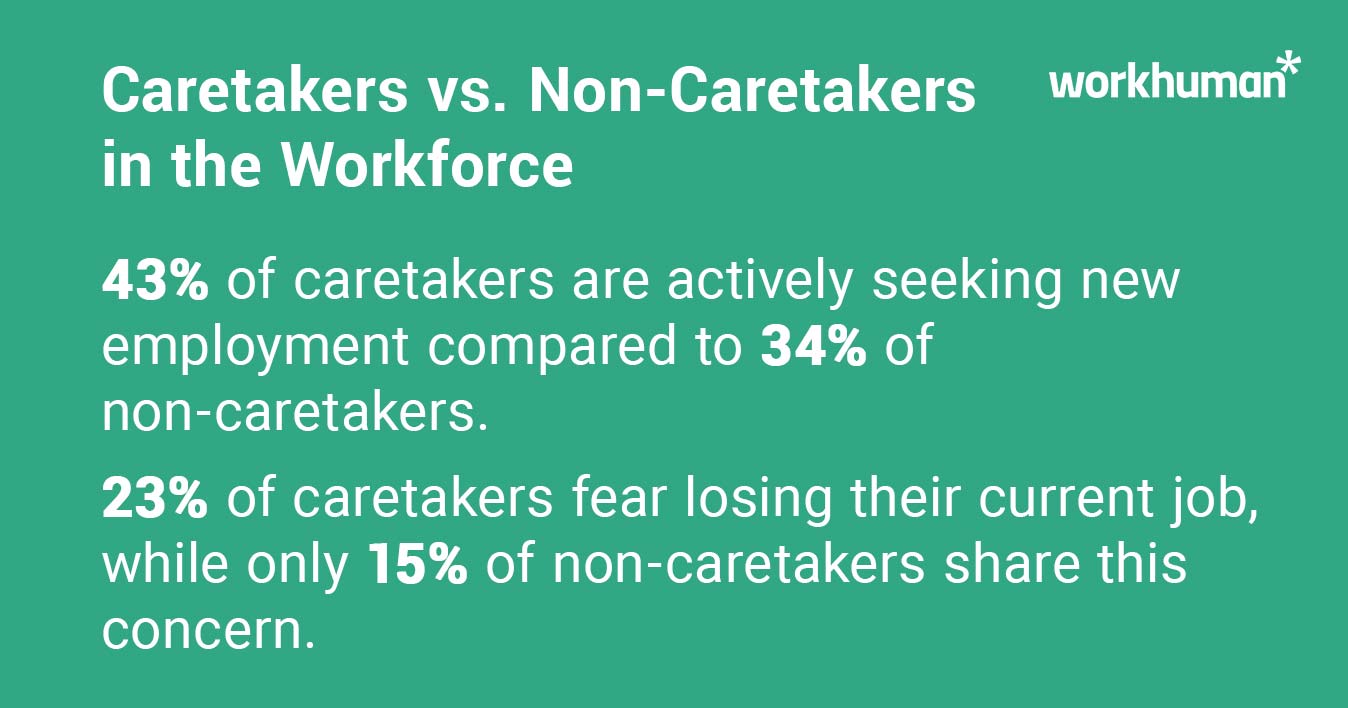
According to the APA's findingsOpens in a new tab, parents reported increases in worry and embarrassment about money stressors post-pandemic more than other adults. As a group, parents also reported higher impacts of stress, including feeling numb and overwhelmed, unfocused, and unable to function.
Read more: How to Empower and Support Working Parents: Challenges & Examples
As a group, women are more likely than men to bear the brunt of caretaking responsibilities, experience financial and career setbacks after becoming parents, and report poor or fair mental health.
The APA found women in America reported feeling "consumed" by their worries about money and family responsibilities more than men. They also reported feeling no one understood how stressed they were more than men and less likely to think they could get over stress quickly.
In 2023, mental health provider CompPsych foundOpens in a new tab that women took 69% of mental health-related absences they reviewed.
Read more: A New Standard for Workplace Culture: An Intersectional Approach to Women Thriving at Work
Underrepresented employee groups
Stress, inequity, and declining psychological safety make it hard for underrepresented employee groups – like LBGTQIA+, BIPOC, and employees with disabilities, to name a few – to feel connected to their communities, their coworkers, and workplace cultures.
The 2023 workplace wellness researchOpens in a new tab published by Mental Health America – a U.S. nonprofit focused on mental health, wellbeing, and condition prevention – found:
- 3 in 5 workers still regularly experience microaggressions at work based on race, and 2 in 5 workers based on gender.
- 73% of workers are not comfortable talking to a manager about mistreatment based on race, gender, or disability.
- Workers with mental (25%) or physical (19%) health conditions or disabilities reported lower overall work health scores.
- Nonbinary, transgender, or gender non-conforming workers have more negative workplace experiences than those identifying as female or male.
- Middle Eastern and North African workers report the lowest work health scores.
Their report details the negative colorations between a lack of identity support and unhealthy workplace experiences, emphasizing the impact of low or high psychological safety on mental health. Despite increased awareness of injustice and inequity in workplaces, employees' experience continues to decline and will likely continue to as leaders deprioritize promises made in the face of economic uncertainty.
Read more: How to Transform Today's DEI Practices: A Case Study with Workhuman & BLK Men in Tech
Both Mental Health America and the APA 2023 surveys noted increased discomfort around talking about the experience of discrimination and inequity and lack of support experienced by underrepresented employee groups.
In fact, most 2023 workplace surveys across industries or demographics show employees are uncomfortable talking about their stress, especially regarding financial, mental, or social wellbeing in the workplace.
The cost of stress and worry
Beyond the physical toll, chronic stress and anxiety stack up to collective impacts on day-to-day operations and long-term business health:
- Burnout and demotivation — 57% of APA's survey respondents indicated experiencing burnout, 31% experiencing emotional exhaustion, and 26% citing lack of motivation.
- Absenteeism — ComPsych reported mental health-related absences in 2023 increased by 33% compared to 2022.
- Turnover — 57% of workersOpens in a new tab unsatisfied with their employer's mental health and wellbeing support said they intend to find a new job at a different company or organization.
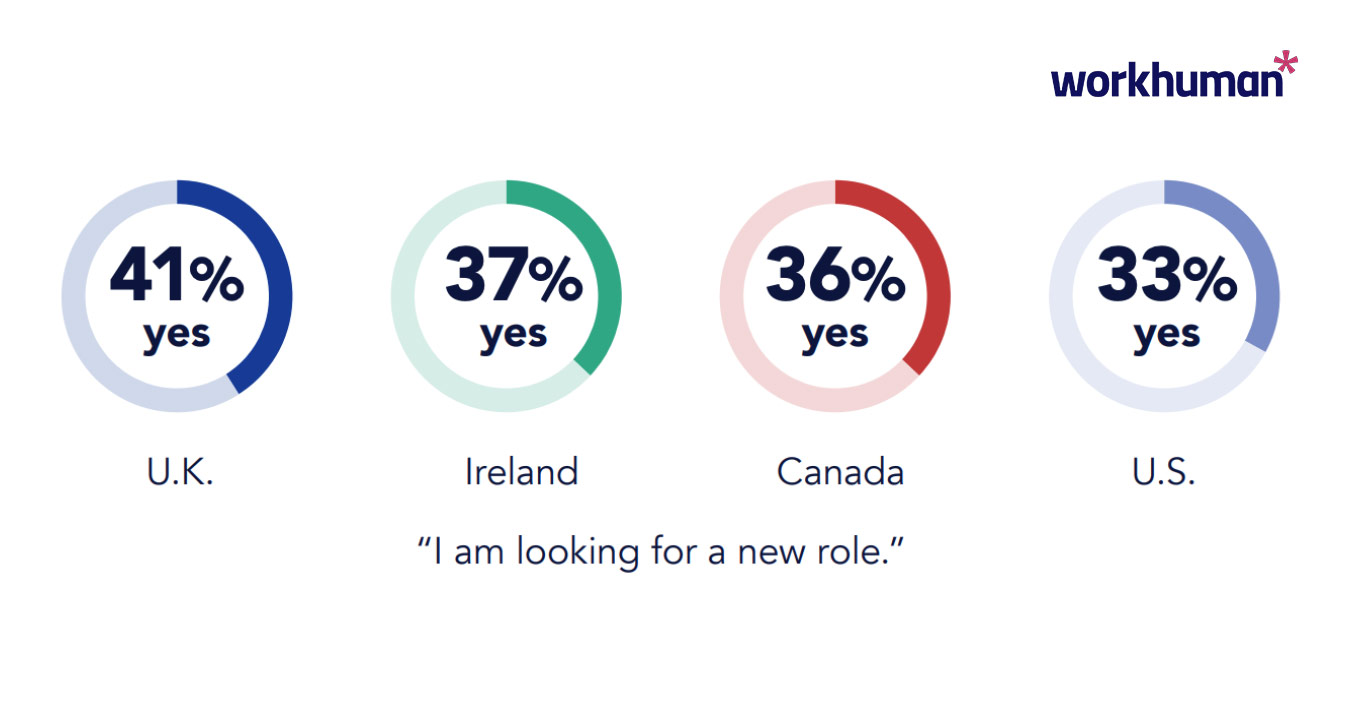
Read on to learn more about supporting your employees based on their individual needs and how this is the most just and sustainable way to run your business.
Impactful ways to support wellbeing & resiliency
Since the pandemic, leaders across organizations and industries have introduced new benefits and programs to support employee mental and physical health. But this is just the first step. Building employee resilience in the workplace requires a system of full-spectrum support.
Let's go back to those everyday macro stressors and look at some impactful ways to reduce stress and increase wellbeing:
Maximizing the impact of financial, physical, and mental health support
Employees struggling in one or more aspects of wellbeing may not have the right mindset or time to fully benefit from these solutions. Build on the awareness and efforts put into providing wellbeing benefits and programs to make a real impact.
Benchmarking and regularly evaluating the use of your benefits and programs will make it easier to investigate trends in usage or low participation. To understand unique challenges, look at your employees' usage, especially trends for groups based on social identity or working styles.
Make sure your benefit options are inclusive and flexible. Do your benefits afford employees culturally responsive and gender-affirming care? Are there enough flexible options for ease of access to resources and providers? Consider making these aspects of ongoing education and outreach related to benefits.
Gallup article The Economic Cost of Poor Employee Mental Health Opens in a new tab found that in 2022, as mental health awareness reached its peak, 57% of workers who reported work hurt their mental health couldn't say for sure if they had mental health support services. "24% report the absence of these services, and another 33% are unaware if they are even available through their employer."
Make benefits and programs a robust part of your onboarding process and continue to reinforce the availability of resources and education throughout the employee lifecycle. If you already have a hub for benefits resources, make sure it's easy to find and navigate and that the resources there are easy to understand.
Consider offering regular education sessions either with a provider or through education sessions, webinars, or training, as well as multiple channels for questions like email, Slack, and office hours.
Create flexibility, autonomy, and opportunity at work
About one-third (32%) of workers surveyed by the APA said they do not have enough flexibility at work to balance their work and personal life. When they did have control, they were much more likely to report "good or excellent mental health than those with unsatisfactory control (79% vs 44%)."
Workhuman iQ found that self-reported stress levels were lower than average among employees who had a say in their work arrangement than those who did not, despite where the employee worked.
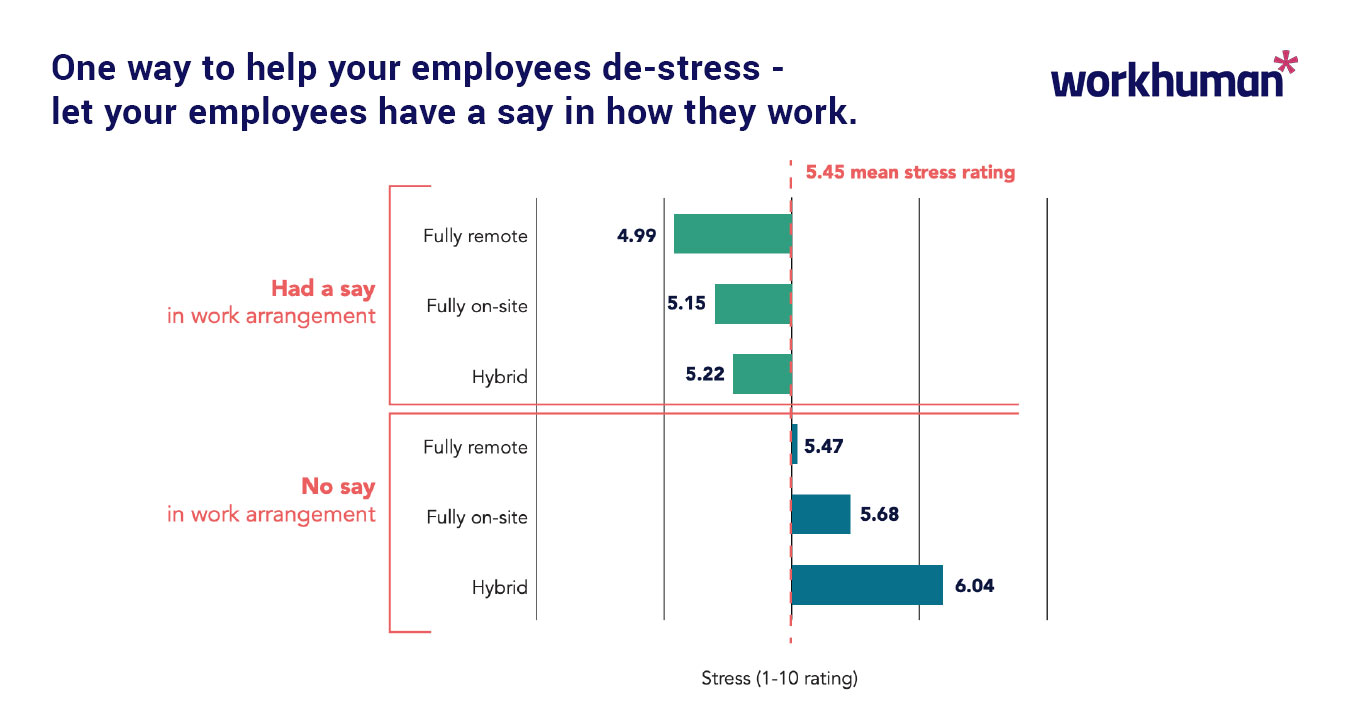
Control doesn't just refer to when and where employees work but also to job autonomy and how much they control what they work on and when.
Through continuous performance management, project and people leaders can help reports evaluate their day-to-day responsibilities and either redesign tasks or reprioritize work against business goals to take the pressure off. Regular career check-ins help employees identify challenges and areas of opportunity to regain a sense of control and progress amidst uncertainty.
HR leaders can help with job redesigns to account for expanding skill sets and responsibilities and design a path for employee growth. You may also facilitate mentorship and skills development opportunities that build strong connections and close organizational gaps. Not only will this improve employees' sense of satisfaction, but it's also a proven tactic to retain talent with long-term gains for the business.
Frequent check-ins also have a proven impact on psychological safety, improving the quality of work and the employee's experience and total wellbeing.
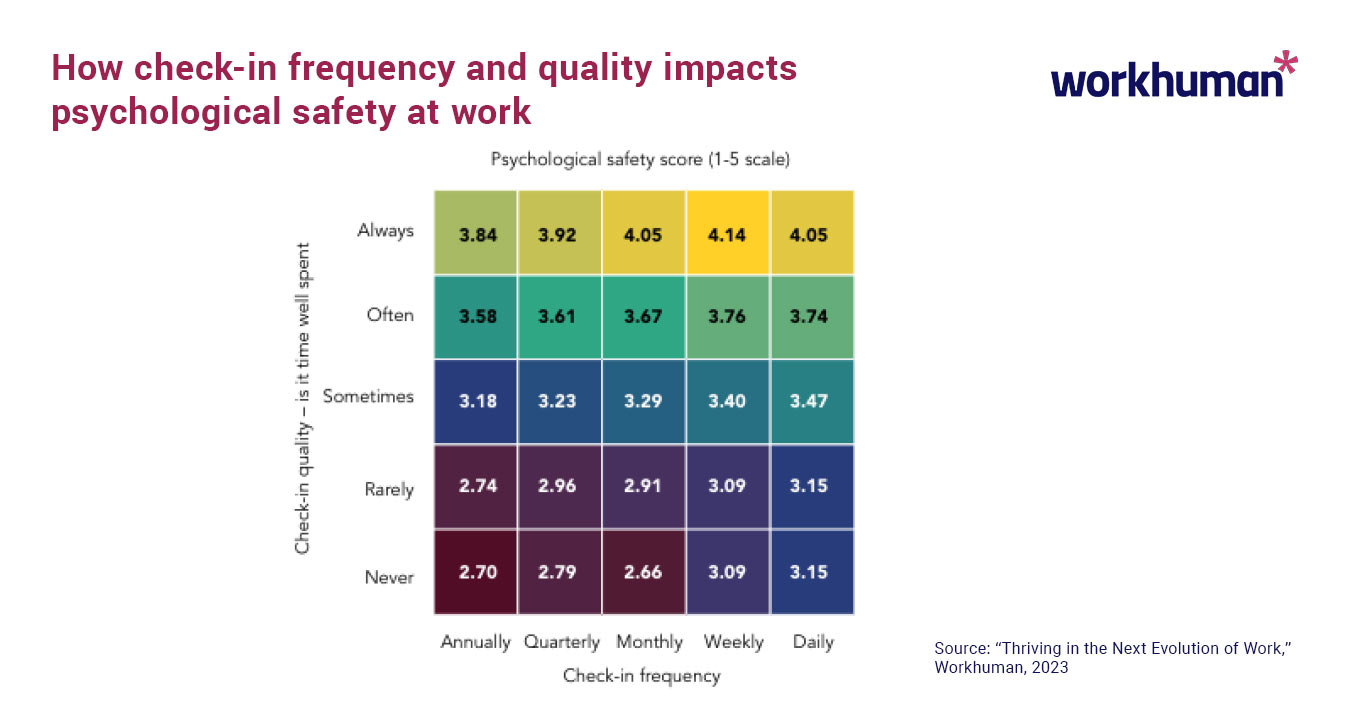
Fostering connection, community & mattering at work
After several years of disruption, employees feel more connected to each other and their managers than to their work, leaders, or organization. When employees feel they belong and psychologically safe at work, they're less likely to experience unmanageable stress.
Friendships and communities within the workplace can improve individual employee experience, but managers have always been the lynch pin. A strong relationship between manager and direct report can positively impact mental health to the same degree as support provided by a spouse or partner, according to findings from UKGOpens in a new tab.
Mental Health America found that when workers believed leadership valued their identities and perspectives, they had a significant and positive impact on both employee mental health and perception of their work environment. To have a large-scale impact on wellbeing, leadership must value and demonstrate the importance of diversity, equity, inclusion, and belonging.
Developing an inclusive, people-first culture starts with an employee listening strategy and understanding the circumstances of people's lives and workplace experiences. Key players in workplace social groups and communities can help contextualize issues and work toward solutions that would bring about meaningful change.
ERG leaders willingly take extra responsibility to bring positive change for marginalized groups, but Workhuman iQ research found that it comes at a cost to their wellbeing.
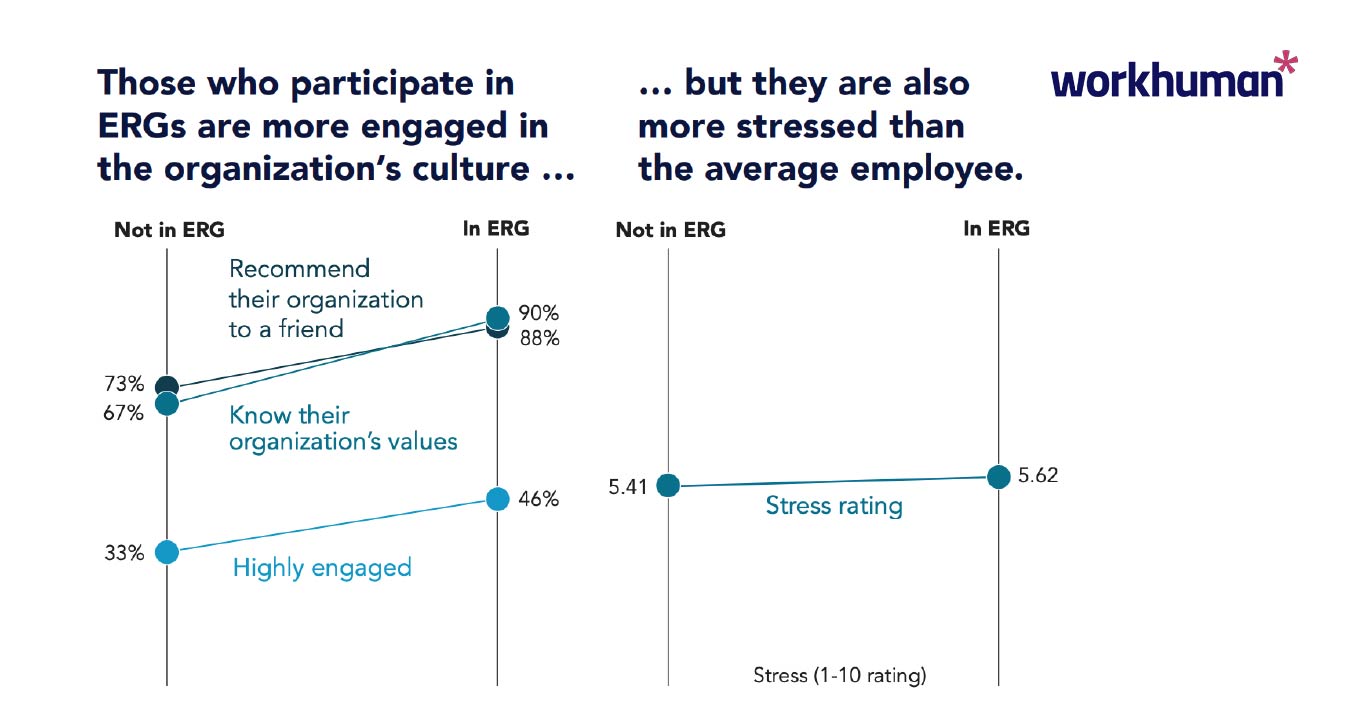
To support them and employees within these groups, start by participating. Get a better understanding of the day-to-day operations and stressors so you can positively influence the unique experiences of different employee groups. Follow the direction of these community leaders, find ways to support and advocate for their initiatives, and recognize their efforts to celebrate and bring greater visibility to their work.
Creating a resilient culture
In their annual survey, Mind Share PartnersOpens in a new tab asked respondents to rate how helpful mental health treatment, self-care resources, a safe and supportive culture, and a healthy and sustainable work culture were on their mental health.
"Among all respondents, a healthy and sustainable culture emerged as the clear winner, with 78% rating it as moderately, very, or extremely helpful. This remained true when segmenting outcomes across gender, generation, LGBTQ+ identity, race and ethnicity, caregiver status, and seniority levels."
For a truly resilient and productive workforce, HR leaders need to reinforce utilizing a range of wellbeing benefits and programs. When coupled with workplace culture changes that support inclusion and belonging, decision-makers can impact individual employee experiences at scale.
About the author
Alison Enzinna
A content strategist and innately curious person, Ali Enzinna has started exploring the working world, looking for opportunities to make big changes through small actions.